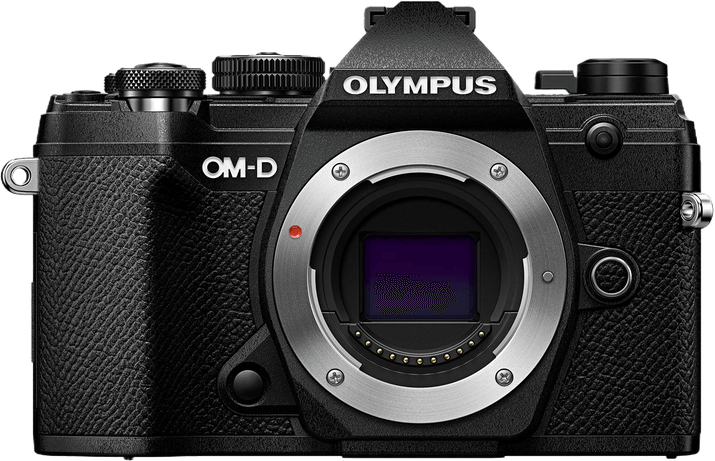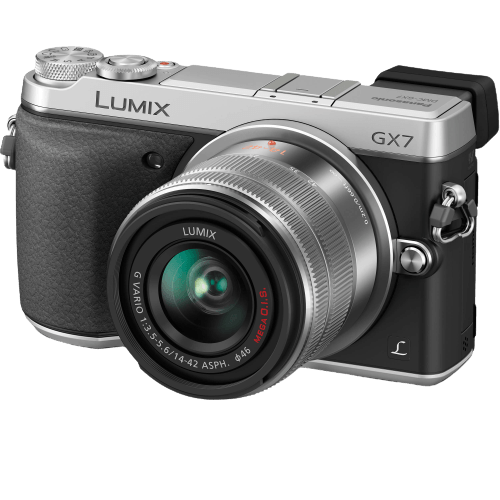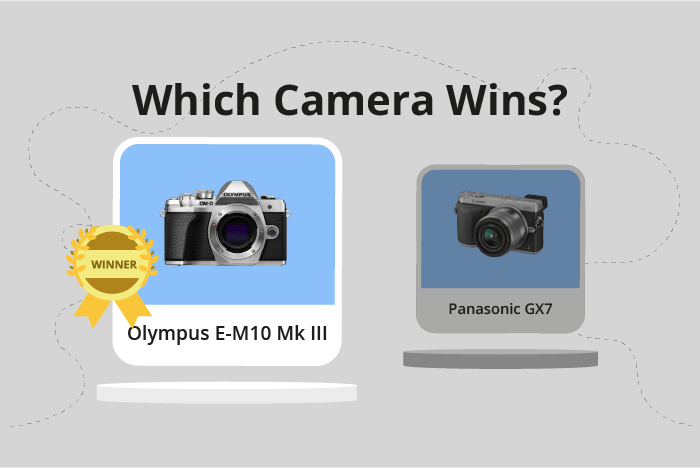Olympus OM-D E-M10 Mark III vs Panasonic Lumix DMC-GX7 Comparison
Olympus OM-D E-M10 Mark III

Panasonic Lumix DMC-GX7

The Olympus OM-D E-M10 Mark III edges out the Panasonic Lumix DMC-GX7 with a score of 54/100 compared to 52/100. Both cameras are mirrorless and have similar sizes and weights, with the Olympus measuring 122 x 84 x 50mm and weighing 410g, and the Panasonic at 123 x 71 x 55mm and 402g.
The Olympus OM-D E-M10 Mark III stands out with its more recent release date in 2017 and a lower launch price of $650, making it a better value for money. On the other hand, the Panasonic Lumix DMC-GX7, released in 2013, has a higher launch price of $999 but offers a slightly more compact design.
Taking into account the scores, release dates, and prices, the Olympus OM-D E-M10 Mark III proves to be a better choice for those looking for a more up-to-date and budget-friendly option, while the Panasonic Lumix DMC-GX7 may appeal to those prioritizing a compact design.
Olympus OM-D E-M10 Mark III vs Panasonic Lumix DMC-GX7 Overview and Optics
The Olympus OM-D E-M10 Mark III emerges as the winner in the optics comparison with a score of 57/100, while the Panasonic Lumix DMC-GX7 trails slightly behind with a score of 54/100. Both cameras share several specifications, including 16-megapixel resolution, CMOS sensor type, Micro Four Thirds sensor size, Micro 4/3 lens mount, and image stabilization.
The OM-D E-M10 Mark III outperforms the Lumix DMC-GX7 in a few key areas. The Olympus camera boasts a faster shooting speed of 8.6 frames per second compared to Panasonic’s 5 frames per second. Furthermore, the OM-D E-M10 Mark III has a TruePic VIII processor, which contributes to its superior performance. The camera also scores higher on the DXOMARK sensor test with a score of 73, compared to the Lumix DMC-GX7’s score of 70.
On the other hand, the Lumix DMC-GX7 has its advantages as well. Though not as powerful as the Olympus’ TruePic VIII processor, the Panasonic camera features a Venus Engine processor that still delivers solid performance. Both cameras have image stabilization, ensuring sharp and steady shots in various conditions.
Taking these factors into account, the Olympus OM-D E-M10 Mark III proves to be the better camera in terms of optics due to its faster shooting speed, more advanced processor, and higher DXOMARK sensor score. However, the Panasonic Lumix DMC-GX7 remains a strong competitor with its own set of features and capabilities. Ultimately, the choice between these two cameras will depend on the user’s specific needs and preferences.
Olympus OM-D E-M10 Mark III vs Panasonic Lumix DMC-GX7 Video Performance
The Olympus OM-D E-M10 Mark III emerges as the winner in the video capabilities comparison with a score of 83/100, significantly outperforming the Panasonic Lumix DMC-GX7, which scores 56/100. Both cameras share some common specifications, such as a maximum video frame rate of 60fps. However, the Olympus OM-D E-M10 Mark III has superior video features that contribute to its higher score.
The Olympus OM-D E-M10 Mark III boasts a maximum video resolution of 4K and video dimensions of 3840 x 2160, while the Panasonic Lumix DMC-GX7 only offers Full HD video resolution with dimensions of 1920 x 1080. This results in the Olympus OM-D E-M10 Mark III producing higher quality and more detailed video footage compared to the Panasonic Lumix DMC-GX7. Additionally, the Olympus OM-D E-M10 Mark III features built-in time-lapse functionality, which the Panasonic Lumix DMC-GX7 lacks. This adds versatility to the Olympus camera, allowing users to capture impressive time-lapse videos.
Although the Panasonic Lumix DMC-GX7 has a lower video score, it still provides users with Full HD video resolution and a 60fps frame rate, which is suitable for casual video shooting and everyday use. However, it falls short when compared to the Olympus OM-D E-M10 Mark III’s advanced video capabilities.
Taking these video features into account, the Olympus OM-D E-M10 Mark III is the better choice for those seeking a camera with superior video capabilities, while the Panasonic Lumix DMC-GX7 remains a viable option for casual users who do not require 4K resolution or time-lapse functionality.
Olympus OM-D E-M10 Mark III vs Panasonic Lumix DMC-GX7 Features and Benefits
The Olympus OM-D E-M10 Mark III and the Panasonic Lumix DMC-GX7 both have a feature score of 57/100, making them equally matched in this category. They share several key specifications, including a 3-inch screen size, 1040000-dot screen resolution, touchscreen capabilities, flip screen, GPS absence, WIFI connectivity, and lack of Bluetooth.
Despite having an identical feature score, the Olympus OM-D E-M10 Mark III excels in certain aspects. However, as both cameras share the same specifications listed above, it is difficult to pinpoint specific areas where the Olympus OM-D E-M10 Mark III outperforms the Panasonic Lumix DMC-GX7 based on the provided information.
Similarly, the Panasonic Lumix DMC-GX7 does not have any distinct advantages over the Olympus OM-D E-M10 Mark III, as they share the same features. Both cameras offer a user-friendly experience with their touchscreens and flip screens, making them suitable for various photography situations. The absence of GPS and Bluetooth in both models may be seen as a drawback, but their WIFI connectivity compensates for these missing features.
Given their equal feature scores and shared specifications, it is challenging to declare a clear winner between the Olympus OM-D E-M10 Mark III and the Panasonic Lumix DMC-GX7. Both cameras provide a satisfactory user experience and are suitable for photographers seeking similar features. Choosing between these two models will ultimately depend on personal preferences and other factors not mentioned in the provided information.
Olympus OM-D E-M10 Mark III vs Panasonic Lumix DMC-GX7 Storage and Battery
The Olympus OM-D E-M10 Mark III and the Panasonic Lumix DMC-GX7 tie with a storage and battery score of 21/100. Both cameras have one memory card slot and accept SD, SDHC, and SDXC memory cards. Neither camera offers USB charging.
The Olympus OM-D E-M10 Mark III is compatible with UHS-II memory cards, enabling faster read and write speeds. However, its battery life is slightly lower, providing 330 shots per charge with its BLS-50 battery.
On the other hand, the Panasonic Lumix DMC-GX7 has a marginally better battery life, offering 350 shots per charge using its 7.2V, 1200 mAh Li-Ion battery. The absence of UHS-II compatibility limits its memory card performance compared to the Olympus model.
Both cameras have their strengths and weaknesses in storage and battery aspects; the Olympus OM-D E-M10 Mark III excels in memory card performance, while the Panasonic Lumix DMC-GX7 offers a slightly longer battery life.
Olympus OM-D E-M10 Mark III vs Panasonic Lumix DMC-GX7 – Our Verdict
Are you still undecided about which camera is right for you? Have a look at these popular comparisons that feature the Olympus OM-D E-M10 Mark III or the Panasonic Lumix DMC-GX7:

